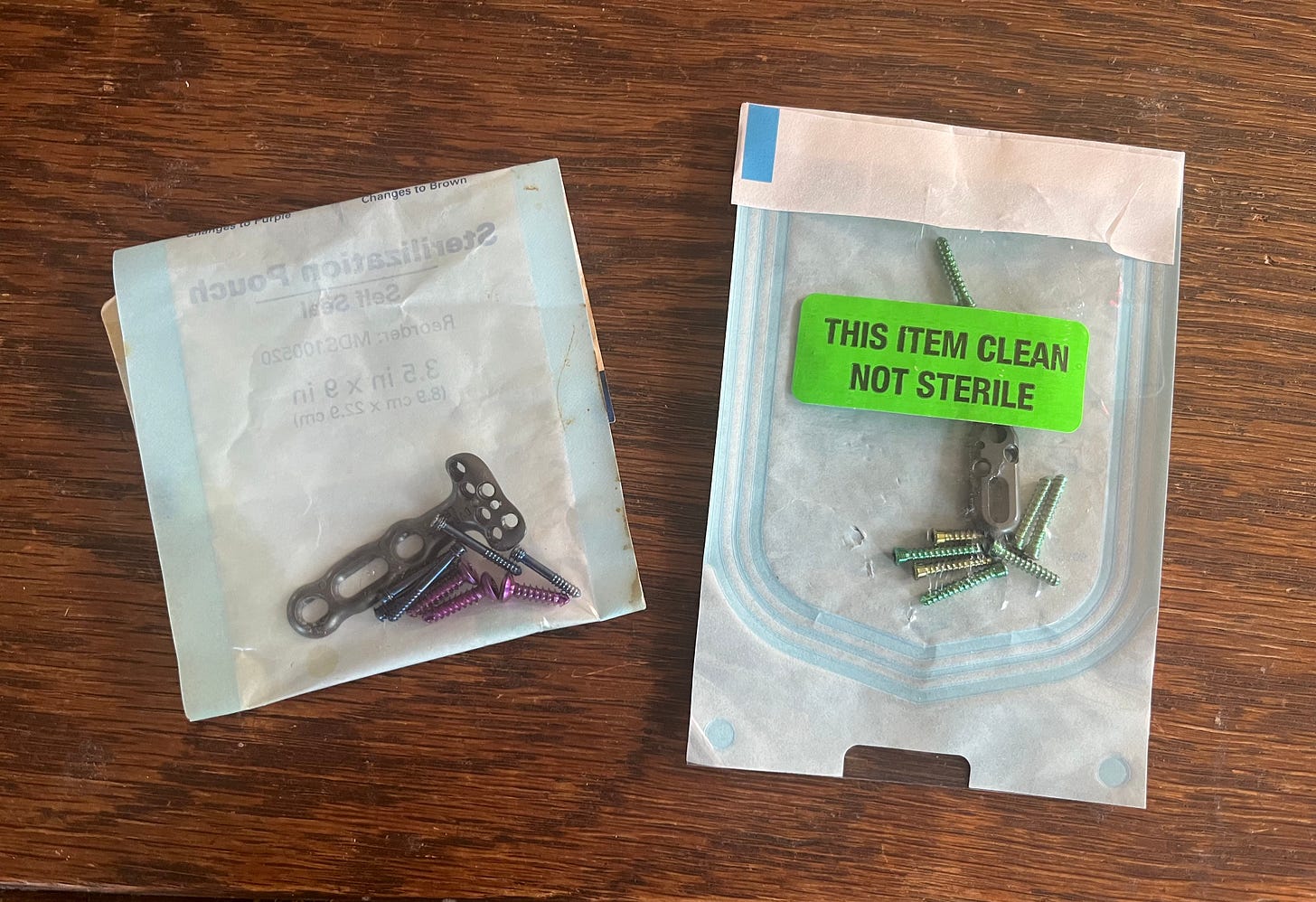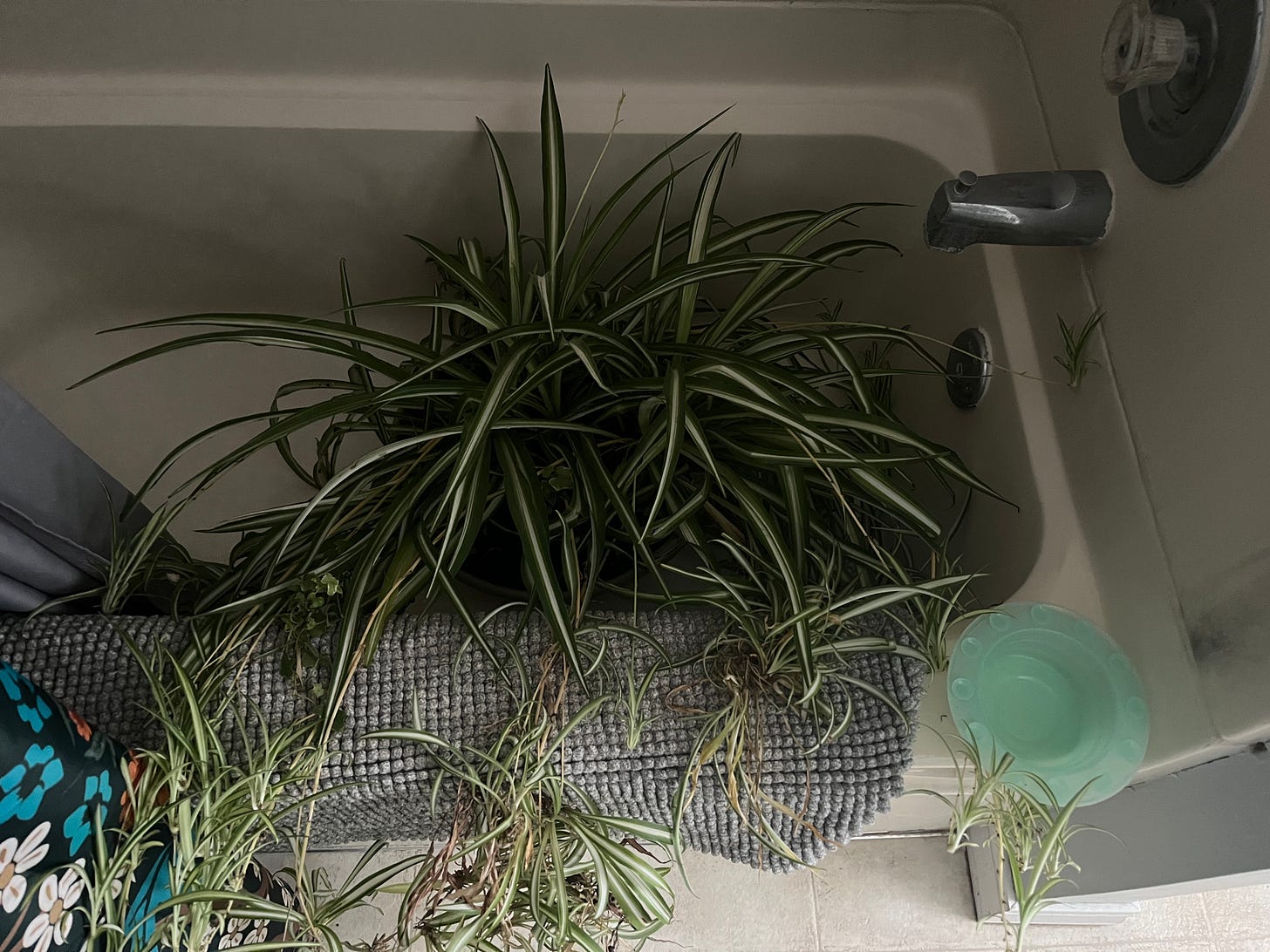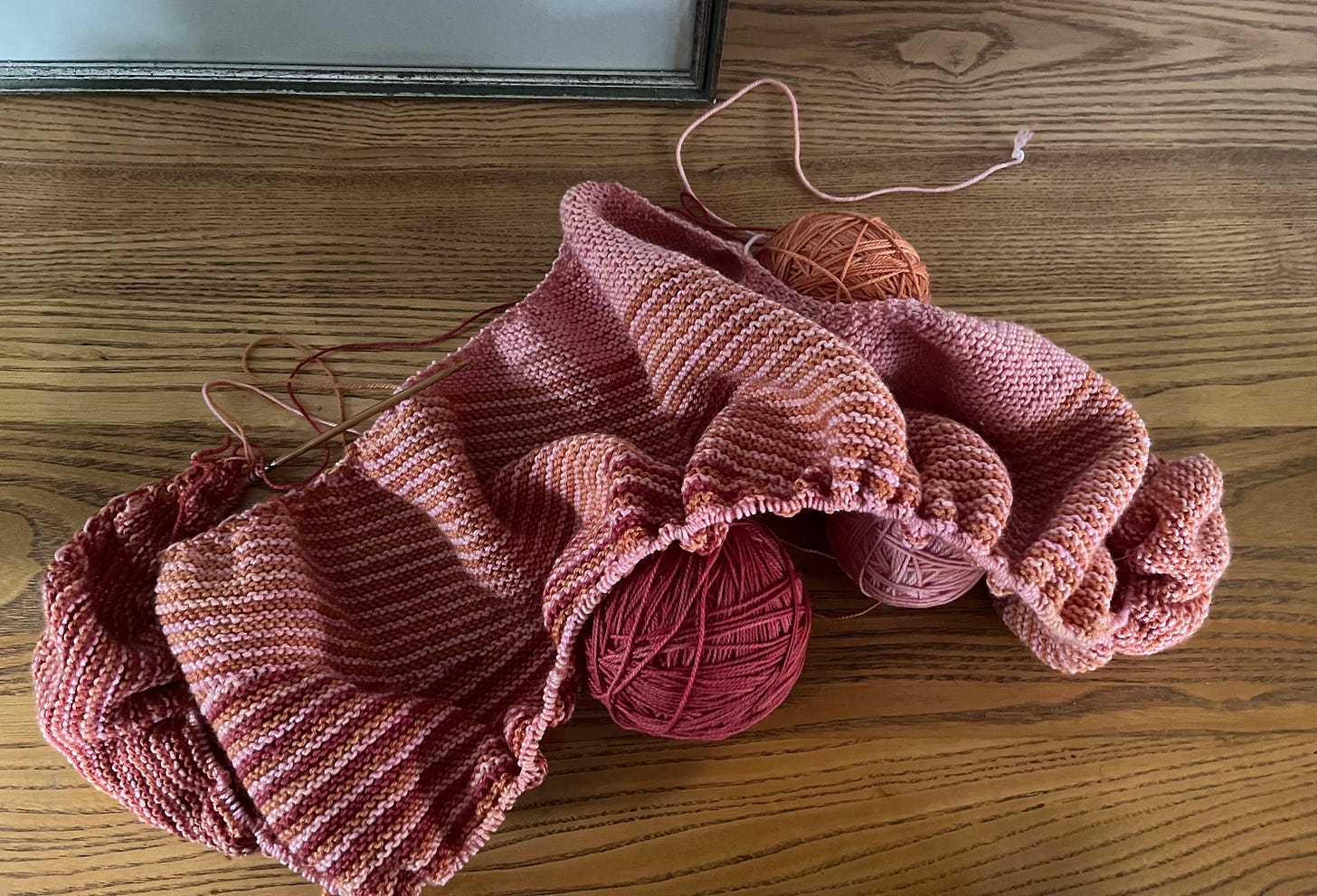Poetry
And just to soothe my mind and heart before so much talk of boundaries, here’s Marie Howe’s poem “Singularity,” reminding me that we’re all, really and only, one.1
Journeying
Last month, just before Christmas, and the day after my dad’s eighty-fourth birthday, my partner and I went to the hospital so that I could have ten screws and one plate removed from my left wrist. It was six in the morning, and I hadn’t eaten since before midnight the previous night. I waited at the check-in desk behind a young woman and her friend. The woman walked with a cane and wore green and black checked pajama bottoms and a stained Carhart jacket. She told the clerk that they had come from Norfolk, a two-hour drive. I checked myself in and found my partner among the maze of padded chairs and privacy barriers in the waiting room. A few minutes later, an older woman who would serve, she told me, as my intake nurse took us back to the pre-op room, where I changed from my layers of street clothes into an entirely inadequate cotton gown and the kind of hospital socks with sticky non-slip dots on their bottom, but without a designated heal. The nurse asked me to confirm my name and date of birth. She asked me to tell her, in my own words, what procedure I was having done today. I told her, “I’m having the hardware removed from my left wrist,” to which she nodded and got on with prepping me for an IV. IV inserted, my doctor arrived to explain the procedure. Again, I affirmed that, “yes,” I do want you to remove the metal that makes my wrist click, pop, and ache. Then he said, “Why don’t we clean it up after we get it out and send it home with you. Do you want it?” Yes, I do. I thought of the plastic “sterilization pouch” at home in my underwear drawer, containing another plate and eight screws, dated February 12, 2010. I had broken this wrist before, had the requisite supporting material inserted and then, two years later, removed due to discomfort. I would add to my collection.
Like my body, my mind rejects scaffolding. I have a questionable relationship with structure, rules, and boundaries. They frighten me. I don’t want anything to control or confine me. If I find myself staring down a week where everything happens at the same time every day, and each of those days is full from the moment I lever myself out of bed to the second I fall back into it, my chest tightens, my stomach knots. I am a newly caged wild animal. However, in the last few years, I have begun to explore, very cautiously, the idea that adding some guardrails to the winding high mountain road of my life might actually create more safety than fear and that a sense of security might, paradoxically, provide me with a more direct experience of the unhindered space I crave.
Back at the beginning of December, I began (without really planning to, which I’ve discovered is the best way to sneak structure into my system-phobic life) a habit of sorts. After I delivered my daughter to school, I would return home and begin making my breakfast. In the still semi-darkness, I did not turn on the overhead kitchen light, but rather the softer one above the stove. Inside this warm halo, I retrieved steel-cut oats and cacao nibs from the cupboard, salt, cinnamon. The oats and some water went into a pan on the stove. I put the other ingredients in a bowl, chopped a pear, and rinsed some blueberries, while I waited for the water to boil. Once it bubbled, I turned the heat down and filled the tea kettle. I prepared my tea and took my numerous vitamins, Chinese medicines, tinctures, and psychiatric medicine. When the oatmeal was sufficiently hot, waterlogged and chewy, I poured it into my bowl with the other ingredients, added some almond milk and carried it and my tea to the dining room table, where I lit the few stubby candles fixed, somewhat precariously, inside old glass yogurt containers. I did not check my phone. I ate for a few minutes and then pulled out the green notebook that my friend V. gave me for my birthday last year, the one with the masking tape label on the cover, where I’d written “Personal Work.” I spent the next twenty minutes or so writing two, sometimes three, penciled pages.
Now, nearly six weeks later, I find that I have deviated little from this routine, although three men and a dog arriving home from college and work mid-month did upset the order a bit. My nervous system likes the slowness, the dependability, dare I say, the ritual-like nature, of doing one thing after the other, while not also doing five other things at the same time. I approach my day with less panic and less cortisol, and I begin it with the most important and joy inducing tasks, eating, drinking a cup of tea, and writing.
I still recoil from externally imposed structure. I don’t like to be told what to do. The metal hardware will stay hidden beneath my bras and underwear, and I don’t plan on acquiring any more specimens. But I’ve learned something about space: it functions best when held. And I can choose to do part of that holding.
Gardening and Making/Mending
This is the kind of gardening I do in January. I took a writing break one morning this week to give my house plants an overdue drink. When I returned to my computer, I caught a whiff of soil in the air. The smell immediately lightened my mood. Evidently, recent research has determined that contact with soil boosts mood by raising serotonin levels.2 No wonder I love to have my hands in the dirt and feel its absence in the cold months. I have lamented to my partner that I would not be able to grow a garden this summer because of our move. I will tend the one I own, until I don’t anymore, which we expect to be in June or July. And I will look for a new home with an eye on the land and what it could be. But to receive a seed catalogue in the mail at this time of year, with so much color and hope in its pages, and then recycle it rather than read and checkmark packets to purchase, depresses me. Maybe I should make a ritual of sticking my nose in my house plants every day as consolation.
This past weekend, my daughter and I participated in a “craft and cats” night with my new friend J., who has three cats, one elderly, two youthful. The fifteen year old ginger cat spent the whole evening asleep on my daughter’s lap. To have a cat in her lap and a sketch book in her hands is bliss for my daughter, and the look on her face brings me joy every time I recall it. I sat on the floor and watched the cat antics, while attempting not to engage (I’m allergic, a true loss). I also worked on the gigantic shawl, which continues to be gigantic and grow more and more so with each round. I’m pondering a return to my sewing machine, although I know I’ve written that here before. I have a sleeveless sweater from Target that I’d like to alter and a pair of pants belonging to my daughter that need hemming. I could do both of these tasks by hand, and I may. Hand sewing is slow and soothing. Much like oatmeal and tea in the morning and sniffing your plants.
And thank you to
for including this poem in his recent newsletter so that I could find it and include it in mine.“The Mood-Boosting Benefits Hidden in Our Soils,” from Earth Trust.




"I still recoil from externally imposed structure. I don't like being told what to do." I resemble that greatly. Thanks for sharing your realization about holding space. That and Marie Howe's poem, "Singularity," are such gifts to me today. Blessings and a hug to you, Emily!
Love the slow and soothing and this really sang to me -- " But I’ve learned something about space: it functions best when held. And I can choose to do part of that holding." Held seems to be my recurring word this year -- slowly making its way into various corners of my life.